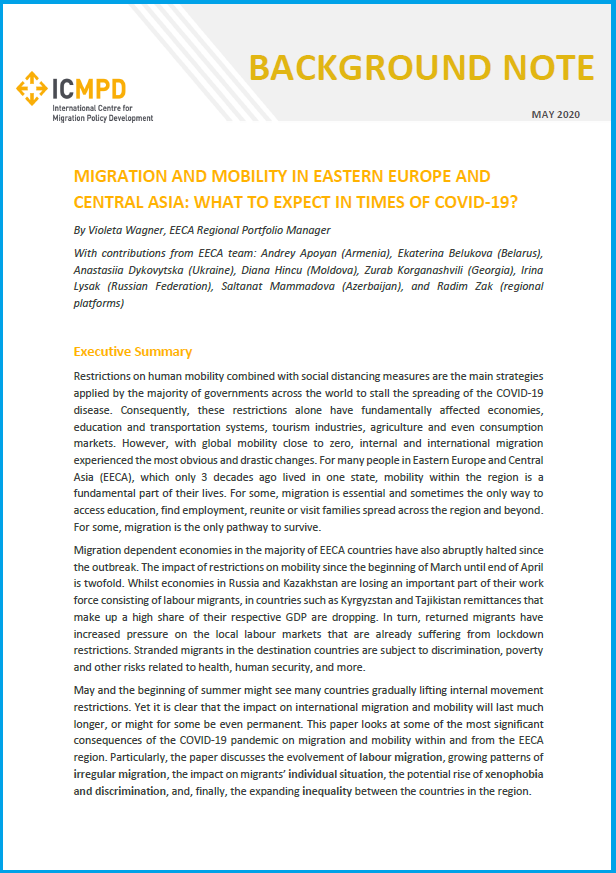Restrictions on human mobility combined with social distancing measures are the main strategies applied by the majority of governments across the world to stall the spreading of the COVID-19 disease. Consequently, these restrictions alone have fundamentally affected economies, education and transportation systems, tourism industries, agriculture and even consumption markets. However, with global mobility close to zero, internal and international migration experienced the most obvious and drastic changes. For many people in Eastern Europe and Central Asia (EECA), which only 3 decades ago lived in one state, mobility within the region is a fundamental part of their lives. For some, migration is essential and sometimes the only way to access education, find employment, reunite or visit families spread across the region and beyond. For some, migration is the only pathway to survive.
The new ICMPD paper "Migration and Mobility in Eastern Europe and Central Asia: What to expect in times of COVID-19?" authored by Violeta Wagner et al. looks at some of the most significant consequences of the COVID-19 pandemic on migration and mobility within and from the EECA region. Particularly, it discusses the evolvement of labour migration, growing patterns of irregular migration, the impact on migrants’ individual situation, the potential rise of xenophobia and discrimination, and, finally, the expanding inequality between the countries in the region.
To preview and download the brief please use this link.
Moreover, our Repository
- Policy brief by Ruslan Minich and Pavlo Kravchuk "The Impact of COVID-19 on Ukrainian Labour Migrants in Czechia, Hungary, Poland and Italy"
- Policy brief by Glen Hodgson "Intra-corporate Transferees (ICTs): The benefits for the EU and the opportunity cost"
- Policy brief by Kristof Tamas "Making the EU’s Migration and Development Policies More Coherent"
- Policy brief by Andriy Orlean "Countering Human Trafficking: Identifying, Returning and Assisting Victims from Ukraine"
- Policy brief by Olga Gulina "Russian nationals looking for refuge in the European Union"
- Policy brief by Dmitry Poletaev "Russia’s Migration Policies after the dissolution of the Federal Migration Service"
- Policy Brief by Yan Matusevich "The EU Central Asia Strategy and Its Impact on Migration"
- Policy brief by Kristof Tamas "Assessing the EU's External Migration Policy"
- Training Manual "How to be a good trainer?"
- Policy Brief by Nermin Oruc and Danica Santic "Highly-skilled Return Migrants to the Western Balkans: Should we count (on) them?"
- Analytical Report by Yelena Sadovskaya "China's "Belt and Road" Initiative and Its Impact on Migration Flows and Policies in Central Asia"
- Policy Brief by Petros Aghababyan "Closing the policy gaps concerning an eventual mass influx of asylum seekers to Armenia"
- Policy Brief by Yan Matusevich "Evaluating the Future of Uzbek Labour Migration"
- Analytical Report by Ivanka Heinzl "Report on the National Action Plan to Fight Trafficking in Human Beings of the Republic of Azerbaijan"
- Policy Brief by Haykanush Chobanyan "Assessing Armenia’s Migration Strategy for 2017-2021"
- Policy Brief by Natia Mestvirishvili "Circular Migration Schemes in Georgia"
- Policy Brief by Katerina Ivashchenko-Stadnik "Ukraine: First visa-free year since introducing the visa-free regime"

